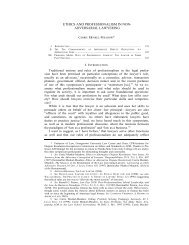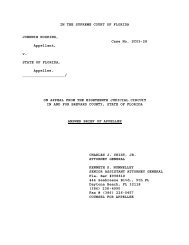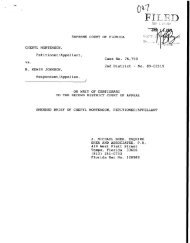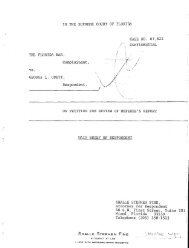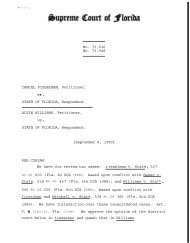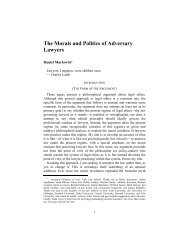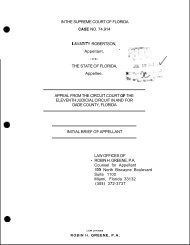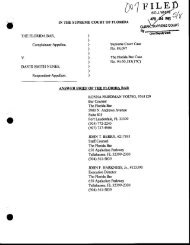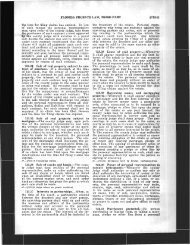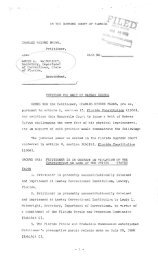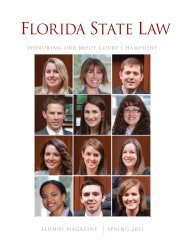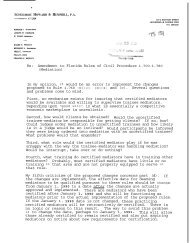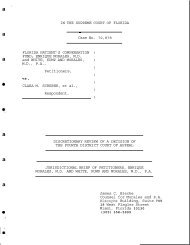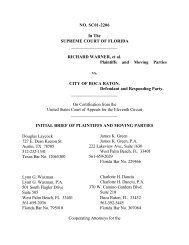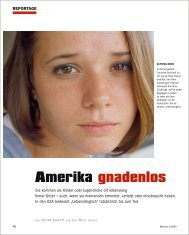Article PDF - Florida State University College of Law
Article PDF - Florida State University College of Law
Article PDF - Florida State University College of Law
- TAGS
- www.law.fsu.edu
Create successful ePaper yourself
Turn your PDF publications into a flip-book with our unique Google optimized e-Paper software.
188 FLORIDA STATE UNIVERSITY LAW REVIEW [Vol. 35:167<br />
painstakingly and earnestly recorded). It is a rebuke to the dignity<br />
<strong>of</strong> the visual artist that our copyright law allows distortion, modification<br />
and even outright permanent destruction <strong>of</strong> such efforts. 140<br />
This focus on individual artists and their individual works shows<br />
that VARA was to be interpreted and applied on a case-by-case basis<br />
and was not intended to exclude specific forms or styles <strong>of</strong> art, since<br />
certain styles <strong>of</strong> art may not have yet achieved positive recognition in<br />
the artistic community. Therefore, at its threshold, VARA should<br />
cover all works that fall under the broad definitions found in section<br />
101. The rights found in VARA then should be applied on a case-bycase<br />
basis using both the flexible standards and the limited exceptions<br />
that address very specific circumstances, notably the public<br />
presentation and the building exceptions.<br />
This is where the First Circuit failed in Phillips. It equated<br />
VARA’s coverage <strong>of</strong> a type <strong>of</strong> art to the protection <strong>of</strong> that type <strong>of</strong><br />
art. 141 The court did not seem to recognize that VARA could apply to<br />
a piece <strong>of</strong> site-specific art and not necessarily protect it in every<br />
situation. 142 Additionally, the court erroneously emphasized that under<br />
the plain language <strong>of</strong> VARA, site-specific art was not protected, 143<br />
and furthermore, “the concept <strong>of</strong> site-specific art [was] never mentioned<br />
by name” in the legislative history <strong>of</strong> the statute. 144 The court’s<br />
reasoning about the plain language <strong>of</strong> the statute did not adequately<br />
address that the broad statutory definition <strong>of</strong> a “work <strong>of</strong> visual” is<br />
based on the physical form <strong>of</strong> a work (such as a painting, sculpture,<br />
or drawing), not the genre or style.<br />
Importantly, the court did not address that VARA codifies more<br />
than just a cause <strong>of</strong> action based in the right <strong>of</strong> integrity. With its<br />
ruling that VARA does not protect site-specific art at all, the First<br />
Circuit denied site-specific artists the ability to exercise the right <strong>of</strong><br />
attribution, the other moral right established by the legislation.<br />
The moral right <strong>of</strong> attribution can be equally important to a sitespecific<br />
artist as the right <strong>of</strong> integrity. The right <strong>of</strong> attribution in<br />
VARA states that an artist:<br />
(1) shall have the right–<br />
(A) to claim authorship <strong>of</strong> that work, and<br />
(B) to prevent the use <strong>of</strong> his or her name as the author <strong>of</strong> any<br />
work <strong>of</strong> visual art which he or she did not create;<br />
(2) shall have the right to prevent the use <strong>of</strong> his or her name as<br />
the author <strong>of</strong> the work <strong>of</strong> visual art in the event <strong>of</strong> a distortion,<br />
140. Id.<br />
141. Phillips v. Pembroke Real Estate, Inc., 459 F.3d 128, 143 (1st Cir. 2006).<br />
142. See id.<br />
143. Id.<br />
144. Id. at 143 n.12.



